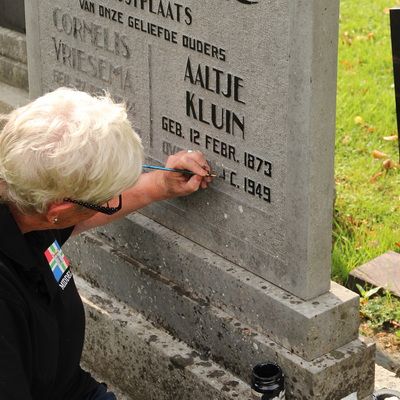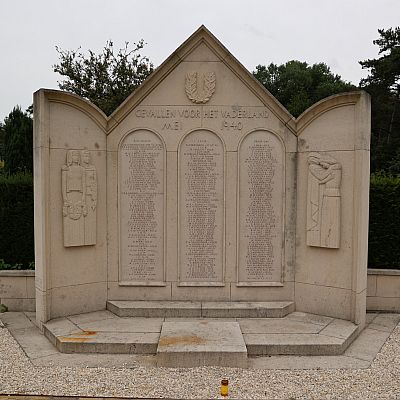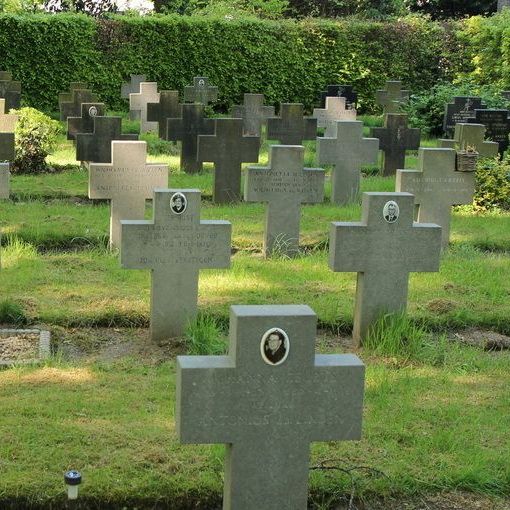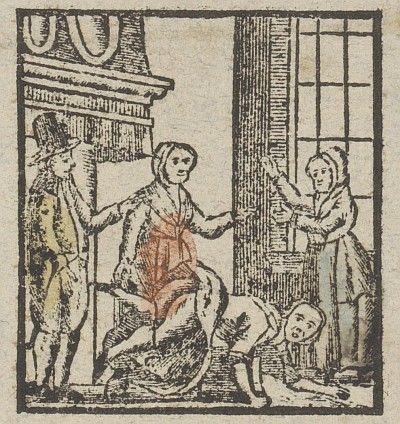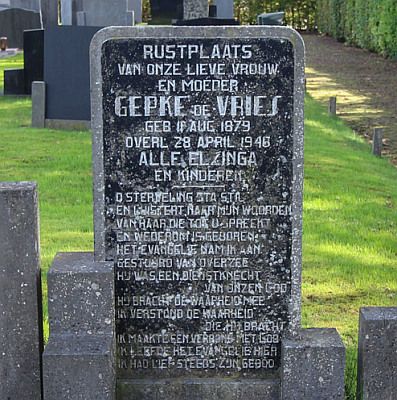The colonial era burial grounds and gravemarkers of the upper mid-Atlantic states (Map 1) have been the focus of little research to date. That which has been conducted primarily concerns the New York / New Jersey gravestone carving tradition, originally established in the British communities circa 1720, and its skillfully crafted sandstone markers. Although slate gravestones were imported from New England prior to this time, the vast majority of the earliest markers were simple, unadorned fieldstones. This study examines the fieldstone traditions of colonial New York, New Jersey, and Delaware; more specifically, those markers erected by and for the descendants of the New Netherland colonists.
Researchers have claimed that other than the possible uninscribed fieldstone, the early Dutch, who in 1624 first colonized the region, did not use gravemarkers until introduced by the English following the 1664 annexation of New Netherland. [1] The reasoning behind such claims center on the fact that surviving markers from the New Netherland period have never been identified or documented. Moreover, extant Dutch language gravemarkers appear decades later than the English in the archaeological record of the American northeast. However, evidence suggests that centuries-old marker traditions were in use before English-inspired headstones were adopted. Unfortunately, most of the earliest markers have been lost over the centuries to development pressures, neglect, and misidentification. Because of this, the final resting places of many of America’s first colonists have been, and risk continuing to be, disturbed. It is therefore important that remaining early stones are properly identified, not only for their own archaeological significance, but also to protect the remains they identify.
Early Dutch Burial Grounds in New York, New Jersey, and Delaware
Although the Dutch language and culture predominated until the mid-1700s in many communities established by New Netherland colonists and their descendants, this group was by no means homogeneous. For example, it was the Swedes who, along with a contingent of Finns, founded Fort Christina (near present-day Wilmington, Delaware) in 1638. There were also large numbers of Norwegians, Danes, Germans, and Walloons absorbed into the Dutch colony from a comparatively early date. In addition, French Huguenots arriving in the years before and after New Netherland was ceded to the English were assimilated as well. [2] These various groups utilized churchyards, public burial grounds, and private family grounds throughout the region for burials; but unfortunately, many of these sites have been and remain threatened due to their proximity to densely settled areas. The earliest burial grounds, which were established in New York’s oldest settlements (i.e. Albany, Manhattan, Brooklyn), had all succumbed to development pressures during the 1800s. Graves, in most cases, were consequently removed to large park-like cemeteries to accommodate urban growth. [3] Gravemarkers, however, did not always make the journey. For example, the gravestones of one of New York’s earliest burial grounds, the Old Dutch Churchyard of New York City, were destroyed when the property was sold off to real estate developers. [4]
Rural plots did not fare much better. Many of the stones of the old private and family grounds that had not been discarded over the years have fallen apart or become buried. In writing on the old colonial town of Bushwick, New York, in 1884, Henry Stiles commented that the ancient graveyard of this settlement had been unused and neglected for many years before its remnants were ultimately deposited under the Bushwick Dutch Reformed Church. [5] And in 1929, as a member of the Saugerties Chapter of the D.A.R., Lila James Roney described the state of early Ulster County, New York, family plots as “fast disappearing, due to farms passing into alien hands.” She also wrote, “the stones… where the earliest settlers of Saugerties were buried, were thrown in the Hudson river.” Further to the status of early Ulster County gravestones, Roney added:
The resting place of the earliest settlers… is completely overgrown with large trees and dense underbrush. Many of the stones have fallen to the ground, and are almost buried from sight. The inscriptions on many of the old field stones have been worn away by the storms of years and the names lost to posterity. [6]
Thus, neglect is another factor contributing heavily to the loss of many early gravemarkers.
Churchyards are some of the most well-maintained of surviving colonial era burial grounds and are home to excellent examples of early fieldstone gravemarkers. However, churchyards dating to the Dutch dominion are limited in number. This is not just due to development, but because of the fact that they were established few and far between. Prior to 1654, there were only two churches in the entire colony and it was not until the final decade of Dutch rule that permanent structures and churchyards were more widely established. [7] Many of the first churchyard burials were clustered around the churches themselves, as were their associated markers. Over time, some structures were enlarged over existing gravesites to accommodate congregational growth. [8] At Flatbush, Hackensack, Kingston, and elsewhere, such was the case and has resulted in an absence of markers identifying the earliest churchyard burials.
Indirect Evidence of Early Marker Use
 There is good reason to believe that burial markers in some form were used prior to English contact. Because they help to identify where space is and is not available for interments, gravemarkers are a very practical tool. While excavating near the site of Albany’s Old Dutch Church, archaeologists came to find that the earliest New Netherland settlers were buried in coffins stacked directly above each other in tiers. [9] This is a practice in which it is necessary to have knowledge of each previously dug grave, particularly when there is a desire to bury people together who have died years apart. In the Netherlands, it was not uncommon for spouses or family members to be buried under the same marker (Fig. 1). During the colonial period, the Dutch in America identified multiple individuals on single markers as well.
There is good reason to believe that burial markers in some form were used prior to English contact. Because they help to identify where space is and is not available for interments, gravemarkers are a very practical tool. While excavating near the site of Albany’s Old Dutch Church, archaeologists came to find that the earliest New Netherland settlers were buried in coffins stacked directly above each other in tiers. [9] This is a practice in which it is necessary to have knowledge of each previously dug grave, particularly when there is a desire to bury people together who have died years apart. In the Netherlands, it was not uncommon for spouses or family members to be buried under the same marker (Fig. 1). During the colonial period, the Dutch in America identified multiple individuals on single markers as well.
Another strong piece of evidence supporting early marker use is the presence of burial markers in the Netherlands, as well as elsewhere in Northern Europe, from an early date. Although stone was scarce, gravestones like the one shown in Figure 1 were erected in the Netherlands during the 1600s. Many of the earliest surviving “Dutch” markers found in the study area appear to be simple versions of the same. In addition, there are some colonial marker forms that resemble traditions common throughout Scandinavia during the Middle Ages. These markers, referred to as runestones for the runic characters carved on them, were known all over the Germanic World and served as memorials to the deceased among other functions. [10] Scandinavians did constitute a large minority segment of New Netherland’s population, but further research is necessary to better link colonial fieldstone traditions to those of Scandinavia during the same period. Nevertheless, there is a possibility that these colonists did play a part in the diffusion of runestone-like marker forms into America. The similarities between the gravemarker traditions are further discussed under the heading, Common Colonial Marker Forms.
New Netherland’s Scandinavian Influence
Estimates place the 1664 population of New Netherland at as much as 9000 colonists, with roughly half representing ancestries other than Dutch. [11] At New Amsterdam (New York City), 13% of marriages between 1639 and 1649 involved a partner from Schleswig-Holstein (then part of Denmark), and 5% from other Scandinavian regions, according to Dutch Reformed Church records. [12] In places like Fort Christina, the Scandinavian element was much greater due to the origins of the settlement. Most of these colonists were Lutherans, as opposed to Calvinists like the Dutch. [13] Further to religion and ethnicity, Fort Orange, near present day Albany, reported “from 70 to 80 [Lutheran] families” in 1659. Equal numbers were documented on Long Island as well. [14] This sizable Scandinavian presence should come as no great surprise to those familiar with Dutch history. During the 17th and 18th centuries, many Scandinavians, particularly Norwegian and Danish sailors and their families, were established in the Netherlands. [15] This period of contact between the Dutch and Scandinavians could have provided ample opportunities for the exchange of cultural traditions, including grave monument forms.
Common Colonial Marker Forms
 From Schenectady, New York, to Wilmington, Delaware, fieldstone gravemarkers still stand in many of the grounds established by the early Dutch, Huguenot, and Scandinavian colonists. The markers are, for the most part, unlike those observed in the colonial English and other British communities, and date back as far as 1710. Two common forms, plank and post-like in appearance, resemble cuts of wood and were possibly skeuomorphs carved in stone for permanence. Additional support for this claim comes from documentary evidence revealing that wood markers were erected at the Knickerbocker Burying Grounds in Albany. A.J. Weise, writing in 1880, mentioned to this effect, “[t]he durability of wood is practically exhibited by the excellent preservation of a pitch pine head board standing in this graveyard.” [16] Wood was also more commonly used to mark gravesites in the Netherlands, as stone was scarce and expensive. [17] There, such gravemarkers were erected well into the 20th century (Fig. 2). It is important to note that any wood markers erected during the New Netherland period would not have survived to the present due to the decomposing nature of the material.
From Schenectady, New York, to Wilmington, Delaware, fieldstone gravemarkers still stand in many of the grounds established by the early Dutch, Huguenot, and Scandinavian colonists. The markers are, for the most part, unlike those observed in the colonial English and other British communities, and date back as far as 1710. Two common forms, plank and post-like in appearance, resemble cuts of wood and were possibly skeuomorphs carved in stone for permanence. Additional support for this claim comes from documentary evidence revealing that wood markers were erected at the Knickerbocker Burying Grounds in Albany. A.J. Weise, writing in 1880, mentioned to this effect, “[t]he durability of wood is practically exhibited by the excellent preservation of a pitch pine head board standing in this graveyard.” [16] Wood was also more commonly used to mark gravesites in the Netherlands, as stone was scarce and expensive. [17] There, such gravemarkers were erected well into the 20th century (Fig. 2). It is important to note that any wood markers erected during the New Netherland period would not have survived to the present due to the decomposing nature of the material.
 In the British communities of the upper mid-Atlantic colonies, it was not uncommon for fieldstone gravemarkers to be hewn in the likeness of the professionally carved markers found in the more urban settlements. For example, tympanums, such as those found on the bedstead gravemarkers of the New England and New York / New Jersey carving traditions, are present on many early fieldstones
In the British communities of the upper mid-Atlantic colonies, it was not uncommon for fieldstone gravemarkers to be hewn in the likeness of the professionally carved markers found in the more urban settlements. For example, tympanums, such as those found on the bedstead gravemarkers of the New England and New York / New Jersey carving traditions, are present on many early fieldstones  in St. Paul’s Churchyard in Mount Vernon, New York (Fig. 3). At times, the English and New Englanders who settled in this area carved symbols on the tympanums as well (Fig. 4). These surviving rough-hewn markers, which date back to 1704, have inscriptions varying from simple initials and a year of death, to a complete name and date of death (Fig. 5).
in St. Paul’s Churchyard in Mount Vernon, New York (Fig. 3). At times, the English and New Englanders who settled in this area carved symbols on the tympanums as well (Fig. 4). These surviving rough-hewn markers, which date back to 1704, have inscriptions varying from simple initials and a year of death, to a complete name and date of death (Fig. 5).
 The earliest actual Dutch language gravemarker identified in the study area was erected around 1690 in the Schenectady Dutch Reformed Churchyard. Incidentally, it was found and removed during the late 1800s from a cellar wall into which it had been built. [18] The marker was plank-like in appearance, measuring 14 x 7 x 4 inches, and inscribed:
The earliest actual Dutch language gravemarker identified in the study area was erected around 1690 in the Schenectady Dutch Reformed Churchyard. Incidentally, it was found and removed during the late 1800s from a cellar wall into which it had been built. [18] The marker was plank-like in appearance, measuring 14 x 7 x 4 inches, and inscribed:
ANNO 1690 / DEN 8 MAY / IS MIN SOON / IN DEN HEERE / GERUST / HENDRICK / IANSEN / VROOMAN / IAN VROOMAN
Which translates to:
ANNO 1690 / THE 8TH OF MAY / MY SON IS / IN THE LORD / AT REST / HENDRICK / JANSEN / VROOMAN / JAN VROOMAN
 Similar gravestones were erected in Kingston, where the earliest date to the 1710s. At New Paltz, where Huguenots had established themselves, these markers are found as well. Although the markers at both sites are similar and feature the characteristic top-end slant, the inscriptions vary. In the Old Dutch Churchyard at Kingston, most do not include much more than the initials of the individual and a date of
Similar gravestones were erected in Kingston, where the earliest date to the 1710s. At New Paltz, where Huguenots had established themselves, these markers are found as well. Although the markers at both sites are similar and feature the characteristic top-end slant, the inscriptions vary. In the Old Dutch Churchyard at Kingston, most do not include much more than the initials of the individual and a date of  death (Fig. 6). The major reasons for this were possibly limited time and carving abilities. In addition, these stones were likely simple gravemarkers and not erected for memorial purposes as elsewhere. For example, some New Paltz markers were creative in the use of inscriptions in acronym form (Fig. 7). The fifth line of the marker in Figure 8, IDHOS, reads in Dutch In Den Heere Ontslapen, which translates to “Sleeping in the Lord.”
death (Fig. 6). The major reasons for this were possibly limited time and carving abilities. In addition, these stones were likely simple gravemarkers and not erected for memorial purposes as elsewhere. For example, some New Paltz markers were creative in the use of inscriptions in acronym form (Fig. 7). The fifth line of the marker in Figure 8, IDHOS, reads in Dutch In Den Heere Ontslapen, which translates to “Sleeping in the Lord.”
 Excellent examples of another type of marker, the post-like fieldstones, stand in Kingston (from the 1720s) and New Paltz (from as early as the 1740s). The markers at Kingston are the earliest identified surviving of their kind and include the top-end slant (Fig. 9). In addition, the churchyard features an extant, rounded-top fieldstone dating to 1737 (Fig. 10). Gravestones like this have been found with either initials only or lacking inscriptions altogether (Fig. 11) in West Nyack, New York, and in
Excellent examples of another type of marker, the post-like fieldstones, stand in Kingston (from the 1720s) and New Paltz (from as early as the 1740s). The markers at Kingston are the earliest identified surviving of their kind and include the top-end slant (Fig. 9). In addition, the churchyard features an extant, rounded-top fieldstone dating to 1737 (Fig. 10). Gravestones like this have been found with either initials only or lacking inscriptions altogether (Fig. 11) in West Nyack, New York, and in  Northern New Jersey at the Old Paramus Burial Ground. At rural Neshanic in Central New Jersey, there is at least one rounded-top, post-like marker from a later date, 1763, which was carved with the full death date and name of the deceased.
Northern New Jersey at the Old Paramus Burial Ground. At rural Neshanic in Central New Jersey, there is at least one rounded-top, post-like marker from a later date, 1763, which was carved with the full death date and name of the deceased.
 The rounded-top feature is characteristic among gravemarkers in the Netherlands from the same period, which suggests that it was introduced to the upper mid-Atlantic colonies via the Dutch. However, Viking Age runestones bearing both rounded (Fig. 12) and slanted-tops (Fig. 13) were carved and erected centuries earlier in Scandinavia. Some runestone-like markers, such as the Viele stone from rural Ancram, New York, in Figure 14, combine the rounded and slanted-top features. This combination is also present on the example in Figure 15
The rounded-top feature is characteristic among gravemarkers in the Netherlands from the same period, which suggests that it was introduced to the upper mid-Atlantic colonies via the Dutch. However, Viking Age runestones bearing both rounded (Fig. 12) and slanted-tops (Fig. 13) were carved and erected centuries earlier in Scandinavia. Some runestone-like markers, such as the Viele stone from rural Ancram, New York, in Figure 14, combine the rounded and slanted-top features. This combination is also present on the example in Figure 15  from Uppsala, Sweden circa the 11th century. As discussed previously, these factors, combined with knowledge that the Dutch and Scandinavians were in early contact with each other, open up the possibility of diffusion via colonists of Scandinavian descent. The question then becomes: did Scandinavian traditions influence marker styles in the Netherlands, which were in turn brought to America by the Dutch? Or, did the traditions arrive in America via Scandinavian colonists, either by way of the Netherlands or
from Uppsala, Sweden circa the 11th century. As discussed previously, these factors, combined with knowledge that the Dutch and Scandinavians were in early contact with each other, open up the possibility of diffusion via colonists of Scandinavian descent. The question then becomes: did Scandinavian traditions influence marker styles in the Netherlands, which were in turn brought to America by the Dutch? Or, did the traditions arrive in America via Scandinavian colonists, either by way of the Netherlands or  Scandinavia direct? Again, further research on the European end is necessary in order to connect these markers to those found in America. There does, however, appear to be enough evidence suggesting the use of distinct burial marker traditions in New Netherland prior to English contact.
Scandinavia direct? Again, further research on the European end is necessary in order to connect these markers to those found in America. There does, however, appear to be enough evidence suggesting the use of distinct burial marker traditions in New Netherland prior to English contact.
 In addition to the plank and post-like markers, a third common form, often trapezoidal (Fig. 16) or pointed in shape (Fig. 17), has been identified in the study area. Like the aforementioned fieldstone types, these markers have runestone-like counterparts as well. Inscriptions on the earliest of these markers, which date to the 1710s at Hackensack, the 1720s at Old Swedes, and the 1730s at Old Paramus, include the initials of the deceased and a year of death.
In addition to the plank and post-like markers, a third common form, often trapezoidal (Fig. 16) or pointed in shape (Fig. 17), has been identified in the study area. Like the aforementioned fieldstone types, these markers have runestone-like counterparts as well. Inscriptions on the earliest of these markers, which date to the 1710s at Hackensack, the 1720s at Old Swedes, and the 1730s at Old Paramus, include the initials of the deceased and a year of death.
 Most of the early fieldstone markers examined had small “+” or other marks separating the initials. It was also not uncommon for some later stones to include these separators between words in full text inscriptions, as shown in the example from Neshanic (Fig. 18). Unlike Old World runestones and British colonial fieldstones, artwork was nearly always absent from colonial Dutch fieldstones. Figure 19 from Hackensack showcases a rare example
Most of the early fieldstone markers examined had small “+” or other marks separating the initials. It was also not uncommon for some later stones to include these separators between words in full text inscriptions, as shown in the example from Neshanic (Fig. 18). Unlike Old World runestones and British colonial fieldstones, artwork was nearly always absent from colonial Dutch fieldstones. Figure 19 from Hackensack showcases a rare example  upon which a symbol was carved. The marker is believed to identify the gravesite of a Native American woman, and the symbol thought to have tribal significance. [19]
upon which a symbol was carved. The marker is believed to identify the gravesite of a Native American woman, and the symbol thought to have tribal significance. [19]
Conclusion
 In summary, evidence suggests that the use of gravemarkers was known to New Netherland colonists and their descendants prior to the arrival of the English in 1664. Gravestones were erected in the Netherlands from a comparatively early date and, for practical purposes, were likely utilized by colonists as well. However, factors such as development pressures, neglect, and misidentification have all contributed to their absence from the archaeological record. As a result, the final resting places of many of America’s earliest colonists remain unknown.
In summary, evidence suggests that the use of gravemarkers was known to New Netherland colonists and their descendants prior to the arrival of the English in 1664. Gravestones were erected in the Netherlands from a comparatively early date and, for practical purposes, were likely utilized by colonists as well. However, factors such as development pressures, neglect, and misidentification have all contributed to their absence from the archaeological record. As a result, the final resting places of many of America’s earliest colonists remain unknown.
 The oldest surviving fieldstone gravemarkers identified during this study of the upper mid-Atlantic region date to the first few decades of the 18th century. Although there is variation among the stone forms, the more common Dutch types are fairly easily distinguishable from their colonial British counterparts. These distinct stones include the plank and post-like markers, as well as the
The oldest surviving fieldstone gravemarkers identified during this study of the upper mid-Atlantic region date to the first few decades of the 18th century. Although there is variation among the stone forms, the more common Dutch types are fairly easily distinguishable from their colonial British counterparts. These distinct stones include the plank and post-like markers, as well as the  trapezoidal and pointed markers. Because they predate the English-inspired gravestones of the New York / New Jersey carving tradition, and were hewn in forms unlike those of most colonial British fieldstones, it is highly likely that the markers represent examples of pre-English contact, New Netherland gravestone forms. The possibility also exists that these forms were inspired by the runestones of Northern Europe and / or were introduced via colonists of Scandinavian descent. In any event, identifying these fieldstones as gravemarkers, particularly in situ, will aid in identifying early colonial burial grounds for further study, as well as potential preservation based on their historic significance.
trapezoidal and pointed markers. Because they predate the English-inspired gravestones of the New York / New Jersey carving tradition, and were hewn in forms unlike those of most colonial British fieldstones, it is highly likely that the markers represent examples of pre-English contact, New Netherland gravestone forms. The possibility also exists that these forms were inspired by the runestones of Northern Europe and / or were introduced via colonists of Scandinavian descent. In any event, identifying these fieldstones as gravemarkers, particularly in situ, will aid in identifying early colonial burial grounds for further study, as well as potential preservation based on their historic significance.
- Robert F. Welch, “The New York and New Jersey Gravestone Carving Tradition,” Markers IV (1987): 1.
- Louis B. Wright, The Cultural Life of the American Colonies: 1607-1763, 1st ed. (New York: Harper & Row, 1962), 47-56.
- Peter D. Shaver, “A Guide to Researching and Preserving New York’s Burial Grounds,” The Preservationist: NYS Office of Parks, Recreation and Historic Preservation 7:2 (Fall/Winter 2003): 7.
- Welch, “NY/NY Carving Tradition,” 33.
- Henry R. Stiles, The Civil, Political, Professional and Ecclesiastical History and Commercial and Industrial Record of the County of Kings and the City of Brooklyn, NY from 1683 to 1884, Volume I. (New York: W.W. Munsell & Company, 1884), 15.
- Lila J. Roney, Gravestone Inscriptions of Ulster County, NY, Volume I. (Copied and Compiled by the Author, 1924), 1.
- Martha B. Flint, Early Long Island: A Colonial Study. (New York: G.P. Putnam’s Sons, 1896), 95.
- Janice K. Sarapin, Old Burial Grounds of New Jersey: A Guide. (New Brunswick, NJ: Rutgers University Press, 2002), 14-15.
- Hartgen Archaeological Associates, Dutch Reformed Church Burial Ground, c1656-1882. (Report prepared by Hartgen Archaeological Associates, Inc., 1986), 5.
- “Runestones,” Wikipedia, http://en.wikipedia.org/wiki/Rune_stone.
- “The New Netherland Dutch,” The Colonial Albany Social History Project, www.nysm.nysed.gov/albany/nnd.html.
- Annals of New Netherland: The Essays of AJF van Laer, ed. Charles T. Gehring, (Albany, NY: New Netherland Project, 1999), 15.
- Robert Alexander, “Religion in Rensselaerswijck,” Selected Rensselaerswijck Seminar Papers. (Albany, NY: The New Netherland Institute, 1986), 311.
- A.J.F. Van Laer, The Lutheran Church in New York, 1649-1772. (New York: The New York Public Library, 1946), 39.
- Theodore C. Blegen, Norwegian Migration to America, 1825-1860. (Northfield, MN: The Norwegian-American Historical Association, 1931), 332.
- A.J. Weise. History of the Seventeen Towns of Rensselaer County from the Colonization of the Manor of Rensselaerwyck to the Present Time. (Troy, NY: J.M. Francis & Tucker, 1880), 65.
- Leon Bok, Personal communication, August 13, 2005.
- Jonathan Pearson, Contributions for the Genealogies of the First Settlers of the Ancient County of Albany, from 1630 to 1800. (Baltimore: Genealogical Publishing Company, 1978), 372.
- Sarapin, Old Burial Grounds, 73.
Nieuw op de website
